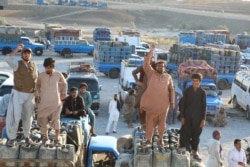Iran has substantially raised its subsidized fuel prices, including gasoline, which has been partially rationed and now is offered in a two-tier pricing system.
As of today, each private sedan will have 60 liters of gasoline monthly at 15,000 rials per liter. This means 15.85 U.S. gallons per car at roughly 50 cents per gallon, based on the current free market exchange rate.
“Free gasoline”, or gasoline above and beyond the rationed quantity for each car will be twice that price or about one dollar per gallon.
Previously gasoline was not rationed and was sold for 10,000 rials per liter. Now, the price of rationed gasoline is 33 percent higher and non-rationed fuel is priced at 30,000 rials per liter; three times higher than before.
Higher fuel prices will lead to more popular dissatisfaction and was a risky step for the government to take. It will also lead to more inflation, making life harder for ordinary people already squeezed by a 40 percent inflation rate.
But Iran’s oil exports have almost stopped under U.S. sanctions and the government is pressed to raise revenues. Iranians use 90 million liters of gasoline every day and if the government makes an average of 8 cents more per liter, it will have an additional seven million dollars a day revenue or $2.5 billion a year.
That is just a fraction of the lost $60 billion oil export income, but any additional revenue can help the government.
Oil export revenues provide between 40-60 percent of the government budget in Iran. However, oil revenues have never been wisely used. When oil was above $100 a barrel for years, Iran had a total estimated income of $700 billion, but nothing tangible remains from that windfall.
Iran’s ruling establishment was discussing raising fuel prices for the past three years but given the volatile public mood and mass unrest in late 2017, bulked at a major price increase.
Selling fuel at higher prices addresses just a fraction of the estimated $60 billion in various subsidies the state provides. The reason for these subsidies is a government-controlled economy, which is only partially dependent on real market forces. Nationalization of major industries after the 1979 revolution set the stage for an inefficient economic system, which over the years became corrupt, often enriching the ruling elite than helping productivity.
Heavily subsidized fuel in Iran leads to large-scale smuggling to neighboring countries where gasoline prices are much higher. For example in Pakistan one liter of gasoline is sold at 80 cents; ten times higher than in Iran. With the new, higher price, the discrepancy still persists.
Iranian media reported Friday morning that “an informed source” in the Interior Ministry has denied reports of protests and setting fire to gas stations. So far, there is no evidence of such incidents but the fact the government is forced to deny rumors, shows the potential volatility of the situation in the country.
ISNA news website quoted the unnamed government source as saying, “Reports published in social media about setting fire to gas stations in various provinces, including Esfahan, Eastern Azerbaijan, Khuzestan and other places is disseminated by foreign-based user accounts and they aim at agitating the people and creating unrest in the country”.
But three years ago, when the government tried to ration fuel, people set fire to a few gas stations.








